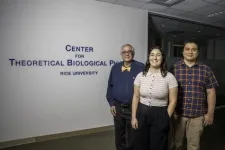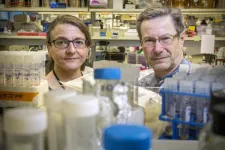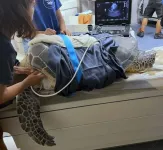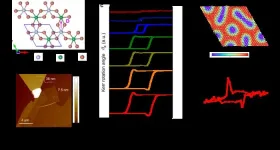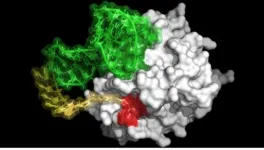(Press-News.org) A deadly strain of cholera bacteria that emerged in Indonesia back in 1961 continues to spread widely to this day, claiming thousands of lives around the world every year, sickening millions — and, with its persistence, baffling scientists. Finally, in a study published today in Nature, researchers from The University of Texas at Austin have discovered how this dangerous strain has held out over decades.
A longstanding mystery about the strain of Vibrio cholerae (V. cholerae) responsible for the seventh global cholera pandemic is how this lineage has managed to out-compete other pathogenic variants. The UT team identified a unique quirk of the immune system that protects the bacteria from a key driver of bacterial evolution.
“This component of the immune system is unique to this strain, and it has likely given it an extraordinary advantage over other V. Cholerae lineages,” said Jack Bravo, a UT postdoctoral researcher in molecular biosciences and corresponding author on the paper. “It has also allowed it to defend against parasitic mobile genetic elements, which has likely played a key part in the ecology and evolution of this strain and ultimately contributed to the longevity of this pandemic lineage.”
Cholera and other bacteria, like all living things, evolve through a series of mutations and adaptations over time, allowing for new developments in a changing environment, such as antibiotic resistance. Some of the drivers of evolution in microbes are even smaller DNA structures called plasmids that infect, exist and replicate inside a bacterium in ways that can change bacterial DNA. Plasmids also can use up energy and cause mutations that are less advantageous for the bacteria.
Through a combination of laboratory analysis and cryo-electron-microscope imaging, the research team identified a unique two-part defense system that these bacteria have that essentially destroys plasmids, thus protecting and preserving the bacterial strain.
The World Health Organization estimates that cholera infects 1.3 million to 4 million people a year and that between 21,000 and 143,000 die annually. The bacterium is usually spread through contaminated water and food or contact with an infected person’s fluids. Severe cases are marked by diarrhea, vomiting and muscle cramps that can lead to dehydration, sometimes fatally. Outbreaks occur mostly in areas with poor sanitation and drinking water infrastructure. Although there is currently a vaccine to fight cholera, protection against severe symptoms drops after only three months. With new interventions needed, researchers say their study offers a potential new avenue for drugmakers to explore.
“This unique defense system could be a target for treatment or prevention,” said David Taylor, associate professor of molecular biosciences at UT and an author on the paper. “If we can remove this defense, it could leave it vulnerable, or if we can turn its own immune system back on the bacteria, it would be an effective way to destroy it.”
The defense system outlined in the paper consists of two parts that work together. One protein targets the DNA of plasmids with remarkable accuracy, and a complementary enzyme shreds the DNA of the plasmid, unwinding the helix of the DNA moving in opposite directions.
Researchers noted that this system is also similar to some of the CRISPR-Cascade complexes, which are also based on bacterial immune systems. The CRISPR discovery eventually revolutionized gene-editing technologies that have brought about massive biomedical breakthroughs.
Delisa A. Ramos, Rodrigo Fregoso Ocampo and Caiden Ingram of UT were also authors on the paper. The research was funded by the National Institute of General Medical Sciences (NIGMS) of the National Institutes of Health and a Welch Foundation research grant.
END
Persistent strain of cholera defends itself against forces of change, scientists find
New clues to longstanding mystery about the longest-running cholera epidemic
2024-05-13
ELSE PRESS RELEASES FROM THIS DATE:
Rice study reveals insights into protein evolution
2024-05-13
Rice University’s Peter Wolynes and his research team have unveiled a breakthrough in understanding how specific genetic sequences, known as pseudogenes, evolve. Their paper was published May 13 by the Proceedings of the National Academy of Sciences of the United States of America Journal.
Led by Wolynes, the D.R. Bullard-Welch Foundation Professor of Science, professor of chemistry, biosciences and physics and astronomy and co-director of the Center for Theoretical Biological Physics (CTBP), the team focused on deciphering the complex energy landscapes of de-evolved, putative protein sequences corresponding to pseudogenes.
Pseudogenes are ...
Low testosterone in men associated with higher risk for death
2024-05-13
Embargoed for release until 5:00 p.m. ET on Monday 13 May 2024
Annals of Internal Medicine Tip Sheet
@Annalsofim
Below please find summaries of new articles that will be published in the next issue of Annals of Internal Medicine. The summaries are not intended to substitute for the full articles as a source of information. This information is under strict embargo and by taking it into possession, media representatives are committing to the terms of the embargo not ...
Chatbots tell people what they want to hear
2024-05-13
Chatbots share limited information, reinforce ideologies, and, as a result, can lead to more polarized thinking when it comes to controversial issues, according to new Johns Hopkins University–led research.
The study challenges perceptions that chatbots are impartial and provides insight into how using conversational search systems could widen the public divide on hot-button issues and leave people vulnerable to manipulation.
“Because people are reading a summary paragraph generated by AI, they think they’re getting unbiased, fact-based answers,” said lead author Ziang Xiao, an assistant professor of computer ...
Herpes cure with gene editing makes progress in laboratory studies
2024-05-13
SEATTLE — May 13, 2024 — Researchers at Fred Hutch Cancer Center have found in pre-clinical studies that an experimental gene therapy for genital and oral herpes removed 90% or more of the infection and suppressed how much virus can be released from an infected individual, which suggests that the therapy would also reduce the spread of the virus.
“Herpes is very sneaky. It hides out among nerve cells and then reawakens and causes painful skin blisters,” said Keith Jerome, MD, PhD, professor ...
Catch and release can give sea turtles the bends #ASA186
2024-05-13
OTTAWA, Ontario, May 13, 2024 – Six out of seven sea turtle species are endangered, and humans are primarily responsible. Commercial fishing activities are the largest human-caused disturbance to sea turtles due to accidental capture.
Fishers are typically unaware if a sea turtle is caught in their net until it’s completely pulled out of the water. However, releasing sea turtles without veterinary evaluations can be harmful. When accidentally caught, the turtles’ normal diving processes are interrupted, ...
Researchers unveil unique tidal disruption event with unprecedented early optical bump
2024-05-13
A research team from the University of Science and Technology of China (USTC) of the Chinese Academy of Sciences (CAS) presented a detailed analysis of a tidal disruption event (TDE) with unique characteristics, providing new insights into the behavior of TDEs and their multiwavelength emissions. The study was published online in The Astrophysical Journal Letters.
When a star ventures too close to a supermassive black hole at the center of a galaxy, it gets torn apart by the black hole's immense tidal forces, resulting ...
Researchers discover "topological hall effect" in two-dimensional quantum magnets
2024-05-13
In a recent study published in Nature Physics, researchers from the Hefei Institutes of Physical Science of the Chinese Academy of Sciences, together with researchers of University of Science and Technology of China, have introduced the concept of the "Topological Kerr Effect" by using the low-temperature magnetic field microscopy system and the magnetic force microscopy imaging system supported by the steady-state high magnetic field experimental facility.
The study holds great promise for advancing our understanding of topological magnetic ...
Like dad and like mum…all in one plant
2024-05-13
In a new study, led by Charles Underwood from the Max Planck Institute for Plant Breeding Research (MPIPZ) in Cologne, Germany, scientists established a system to generate clonal sex cells in tomato plants and used them to design the genomes of offspring. The fertilization of a clonal egg from one parent by a clonal sperm from another parent led to plants containing the complete genetic information of both parents. The study is now published in Nature Genetics.
Hybrid seeds, combining two different parent lines with specific favorable traits, are popular in agriculture as they give rise to robust crops with enhanced productivity, and have been utilized by farmers ...
New molecule mimics the anti-clotting action of blood-sucking organisms
2024-05-13
DURHAM, N.C. – Nature gave ticks, mosquitos and leaches a quick-acting way to keep blood from clotting while they extract their meal from a host.
Now the key to that method has been harnessed by a team of Duke researchers as a potential anti-clotting agent that could be used as an alternative to heparin during angioplasty, dialysis care, surgeries and other procedures.
Publishing in the journal Nature Communications, the researchers describe a synthetic molecule that mimics the effects of compounds in the saliva of blood-sucking critters. Importantly, the new molecule can also ...
Transgender preteens report 13 hours of daily screen time
2024-05-13
Toronto, ON - A new national study found that transgender preteens, 12 and13 years old, reported 13 hours of daily recreational screen time, which was 4.5 hours more than their cisgender peers. Data were collected from 2019 to 2021, overlapping with the COVID-19 pandemic, and the study was published in Annals of Epidemiology.
“Transgender adolescents are more likely to experience school-based bullying and exclusion from peer groups due to their gender identity, leading them to spend less time in traditional school activities and more time on screens,” says lead author, Jason Nagata, MD, associate professor of pediatrics at the University of California, San Francisco. ...
LAST 30 PRESS RELEASES:
Making lighter work of calculating fluid and heat flow
Normalizing blood sugar can halve heart attack risk
Lowering blood sugar cuts heart attack risk in people with prediabetes
Study links genetic variants to risk of blinding eye disease in premature infants
Non-opioid ‘pain sponge’ therapy halts cartilage degeneration and relieves chronic pain
AI can pick up cultural values by mimicking how kids learn
China’s ecological redlines offer fast track to 30 x 30 global conservation goal
Invisible indoor threats: emerging household contaminants and their growing risks to human health
Adding antibody treatment to chemo boosts outcomes for children with rare cancer
Germline pathogenic variants among women without a history of breast cancer
Tanning beds triple melanoma risk, potentially causing broad DNA damage
Unique bond identified as key to viral infection speed
Indoor tanning makes youthful skin much older on a genetic level
Mouse model sheds new light on the causes and potential solutions to human GI problems linked to muscular dystrophy
The Journal of Nuclear Medicine ahead-of-print tip sheet: December 12, 2025
Smarter tools for peering into the microscopic world
Applications open for funding to conduct research in the Kinsey Institute archives
Global measure underestimates the severity of food insecurity
Child survivors of critical illness are missing out on timely follow up care
Risk-based vs annual breast cancer screening / the WISDOM randomized clinical trial
University of Toronto launches Electric Vehicle Innovation Ontario to accelerate advanced EV technologies and build Canada’s innovation advantage
Early relapse predicts poor outcomes in aggressive blood cancer
American College of Lifestyle Medicine applauds two CMS models aligned with lifestyle medicine practice and reimbursement
Clinical trial finds cannabis use not a barrier to quitting nicotine vaping
Supplemental nutrition assistance program policies and food insecurity
Switching immune cells to “night mode” could limit damage after a heart attack, study suggests
URI-based Global RIghts Project report spotlights continued troubling trends in worldwide inhumane treatment
Neutrophils are less aggressive at night, explaining why nighttime heart attacks cause less damage than daytime events
Menopausal hormone therapy may not pose breast cancer risk for women with BRCA mutations
Mobile health tool may improve quality of life for adolescent and young adult breast cancer survivors
[Press-News.org] Persistent strain of cholera defends itself against forces of change, scientists findNew clues to longstanding mystery about the longest-running cholera epidemic
